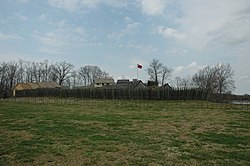Fort Loudoun | |
 Fort Loudoun (20th-century reconstruction) from the outside | |
| Location | Vonore, Tennessee, South bank of Little Tennessee River, about 3/4 miles southeast of U.S. 411 |
|---|---|
| Coordinates | 35°35′45″N 84°12′13″W / 35.59583°N 84.20361°W |
| Area | 50 acres (200,000 m2)[1] |
| Built | 1756–1757 |
| Architect | John William G. De Brahm |
| NRHP reference No. | 66000729 |
| Significant dates | |
| Added to NRHP | October 15, 1966[2] |
| Designated NHL | June 23, 1965[3] |
Fort Loudoun was a British fort located in what is now Monroe County, Tennessee. Constructed from 1756 until 1757 to help garner Cherokee support for the British at the outset of the French and Indian War, the fort was one of the first significant British outposts west of the Appalachian Mountains. The fort was designed by John William Gerard de Brahm, while its construction was supervised by Captain Raymond Demeré; the fort's garrison was commanded by Demeré's brother, Paul Demeré. It was named for the Earl of Loudoun, the commander of British forces in North America at the time.[4]
Relations between the garrison of Fort Loudoun and the local Cherokee inhabitants were initially cordial but soured in 1758 with hostilities between Cherokee fighters and Anglo-American settlers on the frontier in Virginia and South Carolina. After 16 Cherokee chiefs who were being held hostage at Fort Prince George were killed by the garrison on February 16, the Cherokee laid siege to Fort Loudoun in March 1760. The fort's garrison held out for several months, but diminishing supplies forced its surrender in August 1760. Hostile Cherokees attacked the fort's garrison at camp during its return to South Carolina, killing more than two dozen and taking most of the survivors prisoner. Many of them were ransomed.[4]
In retaliation, James Grant led a British expedition against the Middle Towns in North Carolina and Lower Towns in South Carolina. After the Cherokee sued for peace, a peace expedition was made to the Overhill country by Henry Timberlake.
Based on the detailed descriptions of the fort's design by De Brahm and Demeré, and excavations conducted by the Works Progress Administration, the facility was reconstructed in the 1930s. Additional work was supported by the Fort Loudoun Association and the Tennessee Division of Archaeology in the 1970s and 1980s. The fort was designated as a National Historic Landmark in 1965. It was moved and reconstructed above the water levels of Tellico Lake, created in 1979. It is now the focus of Fort Loudoun State Historic Park.
- ^ Cite error: The named reference
nrhpinv2was invoked but never defined (see the help page). - ^ "National Register Information System". National Register of Historic Places. National Park Service. April 15, 2008.
- ^ "Fort Loudoun". National Historic Landmark summary listing. National Park Service. Archived from the original on 2009-03-10. Retrieved 2008-06-27.
- ^ a b Carroll Van West, "Fort Loudoun," Tennessee Encyclopedia of History and Culture. Retrieved: 1 December 2013.

